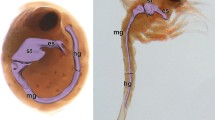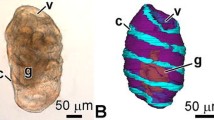Summary
The larval endostyle consists of two ridges of secretory cells, which correspond to the two paired muciparous bands in the endostyles of the adult Branchiostoma, most tunicates, and the lamprey ammocoete. The peculiar shape of the larval endostyle is an effective adaption for food-trapping in the asymmetrical body of the larva. Contrary to general belief, the internal opening of the club-shaped gland is the site of the secretory release, while the exernal opening is an inlet for sea water. The water is mixed with the mucous substance, probably containing neutral glycoproteins, which is produced in the gland tube. This material is released through the internal pore dorsally in the buccal cavity at a position where it is carried with the endostylar secretion towards the intestine. The club-shaped gland is not part of the food-trapping mechanism, but it is apparently an important larval gland which produces substances which may act in the processing of the food or in some other way may direct larval life.
Similar content being viewed by others
References
Barker Jøgensen C (1966) Biology of suspension feeding. Pergamon Press, Oxford
Barrington EJW (1958) The localization of organically bound iodine in the endostyle of Amphioxus. J Mar Biol Assoc UK 37:117–129
Barrington EJW (1979) Invertebrate structure and function. Nelson, London
Barrington EJW, Franchi LL (1956) Organic binding of iodine in the endostyle of Ciona intestinalis. Nature 177:432
Bennett HS, Luft JH (1959) s-collidine as a basis for buffering fixatives. J Biophys Biochem Cytol 6:113–114
Bone Q (1958) Observations upon the living larva of Amphioxus. Publ Staz Zool Napoli 30:458–471
Franz V (1927) Morphologie der Acranier. Ergebn Anat Entw.-geschichte 27:464–692
Goodrich ES (1930) The development of the club-shaped gland in Amphioxus. Q J Microsc Sci 74:155–164
Herlant M (1960) Étude critique de deux techniques nouvelles destinées à mettre en évidence les différentes catégories cellulaires présentes dans la glande pituitaire. Bull Microsc Appl 10:37–44
Kiernan JA (1981) Histological and histochemical methods — theory and practice. Pergamon Press, Oxford
Luppa H (1977) Grundlagen der Histochemie. Teil 1. Akademie-Verlag, Berlin
Naumkina LM, Sakharov DA (1981) Ultrastructure of catecholamine-containing cells of the endostyle of the lancelet Branchiostoma lanceolatum. Dokl Akad Nauk SSSR, ser biol 5–8
Olsson R (1963) Endostyles and endostylar secretions: A comparative study. Acta Zool 44:299–328
Olsson R (1969) Endocrinology of the Agnatha and Protochordata and problems of evolution of vertebrate endocrine systems. Gen Comp Endocrinol Suppl 2:485–499
Orton JH (1914) The ciliary mechanisms on the gill and the mode of feeding in amphioxus, ascidians and Solenomya togata. J Mar Biol Assoc UK 10:19–49
Pearse AGE (1968) Histochemistry. Theoretical and applied. JA Churchill Ltd., London
Schultze M (1851) Beobachtung junger Exemplare von Amphioxus. Z Wiss Zool 3:416–419
Thomas IM (1956) The accumulation of radioactive iodine by Amphioxus. J Mar Biol Assoc UK 35:203–210
Thorpe A, Thorndyke MC (1975) The endostyle in relation to iodine binding. Symp Zool Soc London 36:159–177
Venable JH, Coggeshall R (1965) A simplified lead citrate stain for use in electron microscopy. J Cell Biol 25:407–408
Welsch U, Storch V (1969) Zur Feinstruktur des Kiemendarmes und der „Leber“ von Branchiostoma lanceolatum (Pallas). Z Zellforsch Mikrosk Anat 102:432–446
Wickstead JH (1967) Branchiostoma lanceolatum larvae: some experiments on the effects of thiouracil on metamorphosis. J Mar Biol Assoc UK 47:49–59
Wickstead JH (1975) Chordata: Acrania (Cephalochordate). In: Giese AC, Pearse JS (eds) Reproduction of marine invertebrates, vol. 2. Academic Press, New York
v Wijhe JW (1914) Studien über Amphioxus. I, Mund und Darmkanal während der Metamorphose. Verh Kon Akad Wetensch (2 Sect.), 18 nr 1, Amsterdam
v Wijhe JW (1927) Observations on the adhesive apparatus of Amphioxus in the growth period. Proc Kon Acad Wetensch Amsterdam 30:991–1003
Author information
Authors and Affiliations
Rights and permissions
About this article
Cite this article
Olsson, R. Club-shaped gland and endostyle in larval Branchiostoma lanceolatum (Cephalochordata). Zoomorphology 103, 1–13 (1983). https://doi.org/10.1007/BF00312054
Received:
Issue Date:
DOI: https://doi.org/10.1007/BF00312054




